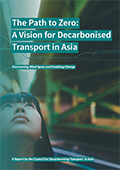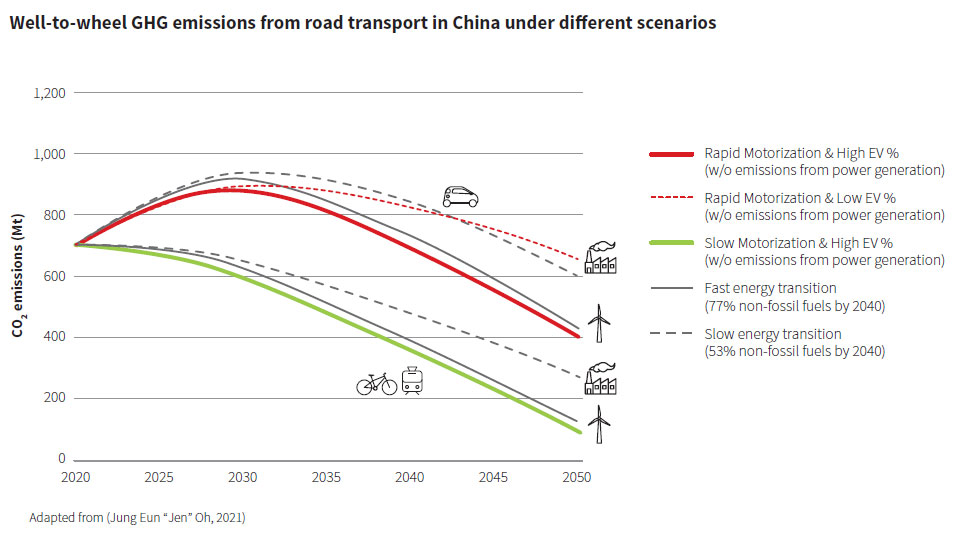The Path Ahead
Trends and what is needed to get to zero-carbon transport
Getting close to zero emissions from the transport sector by 2050 is technically feasible, but many obstacles still need to be overcome to reach this goal.
Zero emissions from the transport sector by 2050 is possible, but we will encounter many obstacles and hazards before we can reach this goal.
MIXED SIGNALS: THE GOOD, THE BAD, AND THE UNCHARTED
Current trends are sending mixed signals and some potentially harmful developments will require careful steering.
Trends that make decarbonisation easier
- Electrification is growing rapidly in many Asian countries, especially among two and three wheelers.
- Scaled-up adoption of 3D printing could massively disrupt traditional manufacturing processes and trade patterns.
- The fuel efficiency of motor vehicles has improved over the last years and will continue to do so.
- Reduced fossil fuel demand could reduce maritime trade volumes.
- More regional trade could reduce global freight activity.
- Teleworking can reduce travel demand.
Trends that can hinder decarbonisation
- Urbanisation puts pressure on urban planners to ensure safe, healthy and timely mobility.
- Increasing incomes and better roads encourage private motorisation.
- Shifting age structures will require special attention
- The demand for freight transport is growing amid increases in global and regional trade.
- The effects of e-commerce depend on the amount of bundling and the amount and mode of private transport that is replaced.
- Vehicle mass keeps increasing.
The trends that can go both ways
- High-speed rail can serve as an alternative for flights but maybe come at a high cost.
- Autonomous driving will only support decarbonisation in combination with shared and electric mobility.
- ‘New mobility’ has improved access but is not automatically low-carbon.

It is time for change. The tipping point for net-zero carbon emission mobility is being reached in several vehicle types and we must support and accelerate the phasing out of ICE vehicles across Asia and the Pacific.
By James Leather,
Asian Development Bank


Read the Council's report
Download the report
THE REQUIREMENTS FOR TRANSITIONING TO ZERO-CARBON TRANSPORT
The tools and technologies to transition towards a zero-carbon transport system are largely known, but only a balanced and integrated avoid-shift-improve approach ensuring a just transition will deliver.
Ensuring a just transition of the economy is essential.
In addition to the intended positive effects of a policy measure, there may be a range of risks for various stakeholders. Understanding these effects is crucial to finding tailored solutions that mitigate negative developments and create a more equitable and sustainable system.
In order to achieve a just transition, we must:
- Protect individuals that are adversely affected by giving them skills training and social security systems.
- Use the transition to create a more just and equitable system that will provide motivation.
- Turn risks to opportunities by transforming the transport industry.
- Utilize social dialogue, social protection measures and funds to help affected communities and enable a just transition.
- Put in place transition funds to help communities move beyond fossil fuel industries.
ILO (2015)Managed well, transitions to environmentally and socially sustainable economies can become a strong driver of job creation, job upgrading, social justice and poverty eradication.
Technical and behavioural changes can get us where we want to go, provided we act fast.
Only a balanced avoid–shift–improve approach will deliver.
Many Asian countries today have high shares of public transport, walking and cycling, mostly because of the large number of people who cannot afford private motor vehicles. The goal here must be to maintain such high shares, but make it a choice rather than a necessity. This must be complemented with solutions that reduce the need for transport activity by avoiding trips and reducing trip length; remaining vehicles must also become more efficient and capable of running on low-carbon or zero-energy sources.
Institution of Council Members
- Sustainable urban planning is key for growing cities in Asia.
- Some proven measures to increase the sustainability of freight are in the interest of freight operators and customers, such as improving load factors, reducing empty running of trucks, optimising routing and reducing energy needs of vehicles.
- Promoting shared transport and active mobility while making individual motorised transport less attractive is essential.
- Shifting freight to rail, waterways and short-sea shipping is essential.
- Remaining vehicles will need to be as efficient as possible and only as big as needed.
- Electrification plays a central role in decarbonising road vehicles.
- High levels of electrification contribute to reducing air pollution, particularly in cities but need to be supported by avoid and shift measures to address congestion and safety concerns.
- Alternative low-carbon fuels are a key element in decarbonising aviation and maritime transport.
- Remaining energy use will need to be renewable.

“Taking steps towards decarbonization through the adoption of electric vehicles will make sure that the energy source will come from renewable energy and be accompanied by the sustainable management of end-of-life vehicles as well as second-life batteries and battery recycling.”
Yossapong Laoonual,
King Mongkut’s University of Technology Thonburi
Existing technical and behavioural changes can get us where we want to go if they are implemented rapidly.
Sustainable urban planning is key for growing cities in Asia.
- Managing growth in large mega-cities as well as guiding the growth of small and medium- sized cities.
- National legislation and budgets need to support cities in implementing their planned low-carbon urban development.
Some proven measures to increase the sustainability of freight are in the interest of freight operators and customers, such as improving load factors, reducing empty running of trucks, optimising routing and reducing energy needs of vehicles.
- Effects of e-commerce depend on the amount of bundling and the amount and mode of private transport that is replaced.
- Urbanisation puts pressure on urban planners to ensure safe, healthy and timely mobility.
- Increasing income and improved road infrastructure encourage private motorisation.
- Shifting age structures will require special attention
- Vehicle mass keeps increasing.
Shifting freight to rail, waterways and short-sea shipping is essential.
- Rail and waterways are the most carbon efficient modes of freight transport, at the same time reducing air pollution and congestion.
- Supporting a shift requires substantial increase in infrastructure investment for expansion as well as the establishment of multi- modal hubs that make transfer to last-mile delivery vehicles efficient.
Remaining vehicles will need to be as efficient as possible and only as big as needed.
- Even with dramatic systematic changes it is predicted that more than 1.5 billion ICE vehicles will be sold globally over the next 30 years. To enable full decarbonisation, these vehicles need to be as efficient as possible.
- This means promoting vehicles that are suited to the use and discouraging oversized vehicles.
Electrification plays a central role in decarbonising road vehicles.
- For heavy-duty trucks the direct use of electricity through batteries may need to be supported through fuel cells and alternative fuels.
- This requires supporting charging infrastructure, the integration of charging into power systems and systems to reuse and recycle batteries after their useful lifetime in vehicles.
- Managing charging patterns will play an important role in integrating renewable electricity with electric mobility and ICT technology will play a key part in delivering this flexibility and ensuring grid stability.
- Rail electrification is equally important, but requires different infrastructure and deals with less individual operators. It has the potential to substantially reduce emissions especially for longer-distance passenger transport and freight, where direct electrification of alternatives is yet challenging.

High levels of electrification contribute to reducing air pollution, particularly in cities but need to be supported by avoid and shift measures to address congestion and safety issues.
- Only a balanced approach across the ASI framework will have the potential to address these challenges jointly with the decarbonisation of the sector, by large-scale improvement of demand management through urban planning and shared mobility solutions. Alternative fuels are a key element in decarbonising aviation and maritime transport.
- The availability of sustainably produced biofuels and renewable electricity-based hydrogen, ammonia and electrofuels, including sustainable aviation fuel, is limited and should be concentrated to use cases where other options, such as direct use of electricity is not feasible, economically or technically.
Remaining energy used will need to be renewable.
- Using more efficient modes of transport and reducing the energy need for individual vehicles is essential to enable a high penetration of renewable energy sources.
It is essential that each country develop a long-term vision of a future mobility system in line with the country’s overall decarbonisation strategy.
Strategies for zero carbon transport need to be translated into concrete policy guidance.
Robust evidence and information are key for successful policies, as are the active engagement of stakeholder groups and efforts to inform the broader public about planned changes and their effects.
A broad set of instruments is available that support the transformation to a zero-carbon transport system.
The appropriate implementation instruments for each local context need to be based on a thorough analysis of existingpolicies. In some cases, existing instruments may need to be adapted or removed for zero-carbon policy instruments to work.